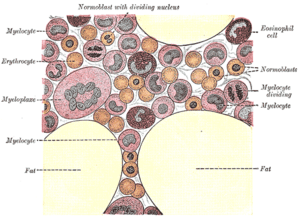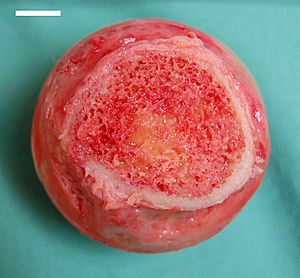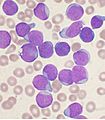Bone marrow facts for kids

Bone marrow is a special type of tissue found inside the hollow parts of many bones in animals, including humans. It's super important because in adults, the bone marrow in large bones creates new blood cells. About 4% of an adult human's weight is bone marrow, which is about 2.6 kilograms.
Contents
Types of Bone Marrow

There are two main kinds of bone marrow: red marrow and yellow marrow.
- Red marrow is mostly made of tissue that produces new blood cells. This is where red blood cells, platelets, and most white blood cells are made.
- Yellow marrow is mainly made of fat cells.
Both types of bone marrow have lots of blood vessels and tiny capillaries running through them.
When a baby is born, all of their bone marrow is red. As they grow up, some of the red marrow changes into yellow marrow. By the time someone is an adult, about half of their bone marrow is red.
You can find red marrow mostly in flat bones like the hip bone, breastbone, skull, ribs, vertebra (the bones of your spine), and shoulder blades. It's also in the spongy ends of long bones, such as the femur (thigh bone) and humerus (upper arm bone). Yellow marrow is found in the hollow middle part of these long bones.
If a person loses a lot of blood, their body can actually change yellow marrow back into red marrow. This helps the body make more blood cells quickly to replace what was lost.
How Bone Marrow Works
Bone marrow is like a factory for blood cells. It contains special cells called hematopoietic stem cells. These are "master cells" that can turn into all the different types of blood cells your body needs.
Every day, human bone marrow produces an amazing 500 billion (that's 500,000,000,000!) new blood cells. These include:
- White blood cells (leukocytes): These fight off infections and diseases.
- Red blood cells (erythrocytes): These carry oxygen all over your body.
- Platelets (thrombocytes): These help your blood clot when you get a cut.
The bone marrow also has other cells that support this blood cell production. For example, some cells help deliver iron to make hemoglobin, which is what makes red blood cells red and helps them carry oxygen.
Bone Marrow's Role in Your Body
Red bone marrow is a very important part of your lymphatic system, which is like your body's defense team. It's one of the main places where lymphocytes, a type of white blood cell, are made from young cells.
The bone marrow and the thymus gland are the primary places where lymphocytes are produced and first checked to make sure they work correctly. Bone marrow also helps prevent lymphatic fluid from flowing backward in the lymphatic system, acting like a valve.
Images for kids
-
Bone marrow aspirate showing normal blood cell production: myelomonocytic cells, erythroid cells, and megakaryocytic cells.
-
A Wright's-stained bone marrow aspirate smear from a patient with leukemia.
-
Bone marrow may have first evolved in Eusthenopteron, a type of ancient fish closely related to early tetrapods (four-legged animals).
See also
 In Spanish: Médula ósea para niños
In Spanish: Médula ósea para niños






